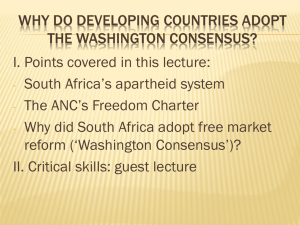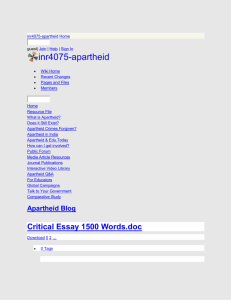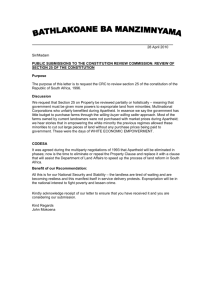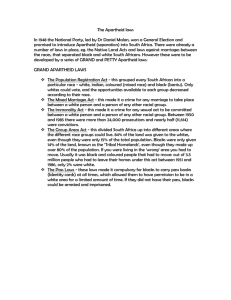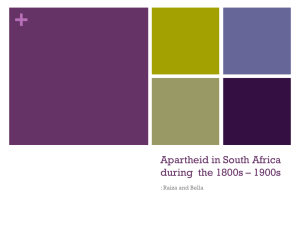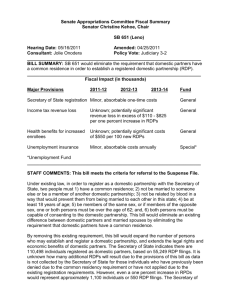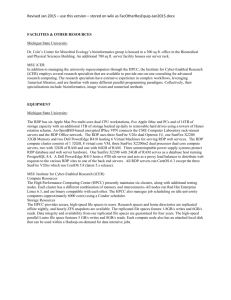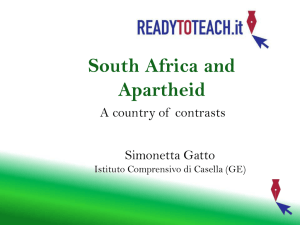Post-Apartheid Housing Policy and the Challenge of Integrating the
advertisement
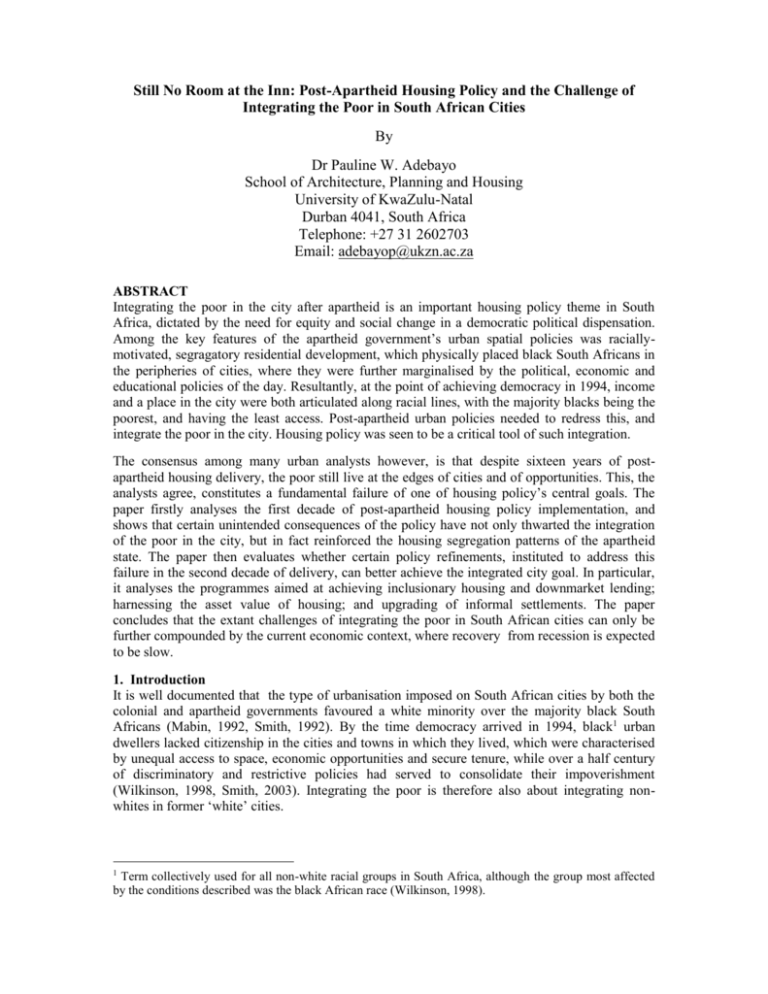
Still No Room at the Inn: Post-Apartheid Housing Policy and the Challenge of Integrating the Poor in South African Cities By Dr Pauline W. Adebayo School of Architecture, Planning and Housing University of KwaZulu-Natal Durban 4041, South Africa Telephone: +27 31 2602703 Email: adebayop@ukzn.ac.za ABSTRACT Integrating the poor in the city after apartheid is an important housing policy theme in South Africa, dictated by the need for equity and social change in a democratic political dispensation. Among the key features of the apartheid government’s urban spatial policies was raciallymotivated, segragatory residential development, which physically placed black South Africans in the peripheries of cities, where they were further marginalised by the political, economic and educational policies of the day. Resultantly, at the point of achieving democracy in 1994, income and a place in the city were both articulated along racial lines, with the majority blacks being the poorest, and having the least access. Post-apartheid urban policies needed to redress this, and integrate the poor in the city. Housing policy was seen to be a critical tool of such integration. The consensus among many urban analysts however, is that despite sixteen years of postapartheid housing delivery, the poor still live at the edges of cities and of opportunities. This, the analysts agree, constitutes a fundamental failure of one of housing policy’s central goals. The paper firstly analyses the first decade of post-apartheid housing policy implementation, and shows that certain unintended consequences of the policy have not only thwarted the integration of the poor in the city, but in fact reinforced the housing segregation patterns of the apartheid state. The paper then evaluates whether certain policy refinements, instituted to address this failure in the second decade of delivery, can better achieve the integrated city goal. In particular, it analyses the programmes aimed at achieving inclusionary housing and downmarket lending; harnessing the asset value of housing; and upgrading of informal settlements. The paper concludes that the extant challenges of integrating the poor in South African cities can only be further compounded by the current economic context, where recovery from recession is expected to be slow. 1. Introduction It is well documented that the type of urbanisation imposed on South African cities by both the colonial and apartheid governments favoured a white minority over the majority black South Africans (Mabin, 1992, Smith, 1992). By the time democracy arrived in 1994, black1 urban dwellers lacked citizenship in the cities and towns in which they lived, which were characterised by unequal access to space, economic opportunities and secure tenure, while over a half century of discriminatory and restrictive policies had served to consolidate their impoverishment (Wilkinson, 1998, Smith, 2003). Integrating the poor is therefore also about integrating nonwhites in former ‘white’ cities. 1 Term collectively used for all non-white racial groups in South Africa, although the group most affected by the conditions described was the black African race (Wilkinson, 1998). Importantly, the planning strategies adopted during apartheid, which had placed black people in their respective ‘group areas’2 and townships in peripheral locations made housing a key area of marginalisation and inequality in the cities. There can therefore be no doubt that making South African cities places for all and integrating the marginalised in the city was a desirable and necessary policy objective, if equity and social change were to be said to have been achieved in the post-apartheid period. Post-apartheid housing policy was key among the urban policies put in place to achieve this objective. In a bid to demonstrate why integrating the poor in the city is an important housing policy theme, this paper begins by briefly outlining the historical background that yielded the segregated, noninclusive cities inherited by the democratic government in 1994. It then discusses post-apartheid housing policy’s objectives in respect of restructuring such cities and integrating the poor in them. The paper then reviews housing delivery in the post-apartheid period in two phases. In reviewing the first phase, constituting the first post-apartheid decade, it explains why housing policy failed in its integrative objectives, and in effect reinforced rather than confronted the apartheid spatial and socioeconomic structure. In the second phase, the paper examines the extent to which some policy refinements that have emerged from such failure can succeed, where previous policy has failed. 2. Why are Poor Urban Dwellers Not ‘in the City’? In line with entrenching cities as domains of white people, numerous governmental measures, including legislation and municipal controlled passes, were put in place over time, aimed at controlling the influx of blacks into, and regulating both their activities and permanence in urban areas. Those permitted in urban areas to serve white capital were, through residential segregation, forced into black townships, which were locationally and administratively separated from the social and spatial fabric of white cities. The housing and services in these townships were moreover inferior, and the housing experience of blacks worsened by the townships’ inconvenient location relative to sources of employment (Wilkinson, 1998, Smith, 2003). The measures to regulate black urbanisation were however unsuccessful, because of the push factor of deteriorating living conditions in the reserves to which blacks (not needed in urban areas) were restricted, as well as the tide of contemporary urbanisation. New migrants were, due to their illegal presence in the urban areas, as well as the affordability challenge of any other type of urban housing, illegally accommodated in informal housing built in the backyards of existing townships. Informal settlements also developed on the fringes of towns and cities, and their expansion was uncontrollable. By the time new township housing construction ceased altogether in the late 1960s, existing townships were bursting at the seams due to overcrowding, and their meagre services were completely overstretched (Mabin, 1992, Wilkinson, 1998). By the mid 1970s, these untenable living conditions as well as intensified influx control, worsening unemployment and poverty and raised political activism, sparked a wave of township uprisings in 1976, through which black urban dwellers made clear their rejection of their imposed housing hardship and marginalisation (Wilkinson, 1998). In the wake of the uprisings, the government established the Urban Foundation (UF) in 1977 to address the problems of black urban communities. The UF’s response was to facilitate black housing ownership through both self-help housing and privatisation of public housing. These measures had limited success however, due to the target group’s inability to effect its demand for housing. As a result of continuing poverty. Moreover, the limited housing delivered through self-help was in peripheral locations, thereby maintaining residential segregation (Tomlinson R, 1990). To address the 2 Areas that accommodated the groups represented in the broader black group, namely the Indian, Coloured and African racial groups. 2 indicated demand-side omissions of the UF and enable blacks to acquire formal housing, a pilot scheme of once-off capital grants was put in place by a parastatal, the Independent Development Trust (IDT) in 1990, enabling acquisition by low income households of 100 000 serviced sites on which they could build their housing incrementally, using their own resources. This IDT housing delivery model of serviced sites in planned townships, funded through a capital subsidy was adopted in the post-apartheid housing policy (Huchzermeyer, 2001, Khan, 2003a). The postapartheid model however includes a 30m² starter house, dubbed the RDP3 house in the first decade of the policy, and subsequently the BNG house4. It’s incremental consolidation would be the responsibility of the recipient (Department of Housing, 1994, 2004). The IDT programme was however too limited in scale to impact both the housing deficit and the urban structure that had been decades in the making. Thus, despite its housing respite in the late apartheid period, South African cities were still highly unequitable in 1994, and the apartheid legacy of peripherisation of housing and buffer zones between races, urban isolation and poverty of black urban dwellers was carried into the post-apartheid era largely intact (Brenmer, 2000, Smith, 2003). Post-apartheid urban policies therefore needed to redress this by conferring the long-denied urban ‘citizenship’ to poor, mainly black households, and integrating them in the city. 3. Post-apartheid Housing Policy and Integrating the Poor The goal of creating more inclusive cities in South Africa is embedded in the broader goal of urban restructuring, which is aimed at redressing the skewed spatial structure of the apartheid city and its resultant social-spatial marginalisation of the poor. It is also important for urban restructuring that the poor’s access to economic opportunities, consumption, infrastructure and social facilities be enhanced. Some of the planning interventions mooted to achieve this include mixed use activity corridors/nodes and higher density developments, aimed at achieving a more compact city (Charlton, 2001, Oelofse, 2003, Todes, 2003). In respect of housing policy, an important goal of both the Housing White Paper (HWP) of 19945 (Department of Housing, 1994), and the Housing Act (107 of 1997), was to reverse the housing delivery pattern that had ignored the social, environmental and economic consequences of peripheral locations for the poor. The National Urban Development Framework of 1997 (Department of Housing, 1997, Pieterse, 2003) reiterated this objective and sharpened its focus, while specifically advocating for strategies that would achieve the integrated co-location of urban functions and their efficient functioning. And while some like Oelofse (2003) have dismissed as simplistic the interpretation of this goal as the mere juxtaposition of compaction on the sprawled, fragmented, low density city and the location of new low income housing developments close to former ‘white’ residential areas, this is how the achievement of this goal was generally understood. Thus, new housing for the poor would be developed on underutilised or vacant land in the inner city or on buffer zones, while informal settlements in good locations would be legalised and upgraded. The government itself acknowledges it’s inadvertent effect of perpetuating social, spatial and economic segregation of the poor with its huge post-apartheid housing programme. Indeed, the 3 Acronym of the Reconstruction and Development Programme of the African National Congress (ANC) party, which led the first democratic government in 1994. 4 Named after the Breaking New Ground (BNG) policy of 2004, although RDP housing is the term still more commonly used. The first post apartheid housing policy document, dubbed ‘a new housing policy and strategy for South Africa’ (Department of Housing, 1994). 5 3 refinements to the first decade of policy, contained in the Breaking New Ground (BNG) policy of 2004 are aimed at addressing the first decade’s housing delivery failure in extending “existing housing areas, often on the urban periphery, thereby achieving limited integration” (Department of Housing, 2004). The main hurdles to integrating the poor in the city using housing policy can be attributed to a number of important factors, whose complexities became manifest particularly in implementation. These are discussed below and include the outcome of the national housing subsidy scheme; the differing locational needs of the poor in the city; the impact of the market on policy implementation; the questionable asset value of RDP housing; and the unfamiliarity with the concept of an integrated urban form in South Africa. 4. Challenges to Integrating the Poor 4.1 The Housing Subsidy Scheme The national subsidy scheme, introduced in 1994, is considered the cornerstone of low income housing policy in South Africa. As indicated elsewhere, it is a once-off capital grant, applied on a sliding scale according to household income, with the lowest income households receiving the highest subsidy (Behrens and Wilkinson, 2003). The subsidy is used to secure a site, basic services and a 30m² starter house. In the first decade of post-apartheid delivery, the 1.6 million subsidised starter houses built in new townships were overwhelmingly located on cheap, peripherally located land (Khan and Ambert, 2003, Department of Housing, 2004). This outcome was the result of a number of factors. Firstly, much housing was unquestioningly developed on peripheral land already purchased for township development by the apartheid government in the 1980s (Huchzermeyer, 2003), which unwittingly thwarted the integration objective of post-apartheid policy. Secondly, in order to maximise the size of the starter house achievable, as well as achieve the large quantities of housing called for by the HWP, the National Department of Housing was overly prescriptive with regard to the portion of the housing subsidy that could be used to purchase land. In addition, the Department’s on-site water and sanitation requirements to for example, deal with on-site grey water disposal, implied relatively larger sites (Charlton, 2003). To achieve both these objectives, cheap peripheral land, adjacent to or beyond existing townships, often with inferior physical characteristics, was inevitably targeted for housing development, as better located land was unaffordable by subsidy funds. While in principle, municipalities could supplement subsidy monies to acquire better located land, most were not in a position to do so (Adebayo, 2009). The isolation of such projects was further compounded by a failure to integrate them with the necessary public facilities and amenities, mainly because of the fragmented nature of institutional arrangements for delivery (Todes, 2000, Khan and Ambert, 2003, Gilbert, 2004). The BNG’s review of the subsidy scheme was therefore in part an acknowledgement of the subsidy scheme’s inability to integrate the poor through better located settlements. 4.2 The Differing Locational Needs of the Poor in the City An important limitation to the poor’s integration in the city in the first post-apartheid decade proved to be the insufficient understanding of their locational needs. While post-apartheid housing policy interprets the meaning of good housing location for the poor as being related to its proximity to the Central Business District (CBD), studies conducted in five of South Africa’s largest cities6 all strongly suggest this to be an oversimplification of a complex issue (Schoonraad, 2000, Todes et al, 2000, Biermann, 2004, Venter et al, 2004). In looking at this issue, Napier (2006) firstly notes that “the ‘poor’ are not all of a piece. There are many and varied household situations in which each has its own aspirations and livelihood strategy.” 6 Johannesburg, Pretoria, Durban, Cape Town and Port Elizabeth 4 Accordingly, Royston (2003) argues for the need to disaggregate the poor into different groupings with different locational requirements, while Charlton (2003) calls for developments that appropriately respond to these requirements. Both Schoonraad and Biermann advance these views by pointing out circumstances under which peripheral locations may very well favour the poor, for example if their plot sizes lend themselves to informal service industry or home-based enterprise activity. At the same time, the locational requirements of low income people with formal employment in the CBD and other formal employment nodes would relate to ease of access to these, whereas people seeking or engaged in unskilled, semi-skilled and domestic occupations might favour locations close to elite suburbs where such opportunities are found. Many analysts link the lack of integration of the poor in the city to the overwhelmingly peripheral developments (Irurah and Boshoff, 2003, Huchzermeyer, 2003, Napier, 2006 among others). In the first decade of delivery, this ‘one size fits all’ approach disadvantaged those whose livelihood imperatives required alternative locations. Anecdotal evidence of RDP housing recipients who have sold or let their peripherally located properties and moved into inner city and other strategically located informal settlements would seem to confirm this view. Royston however also contends that from a spatial integration perspective, the poor’s lack of integration may have more to do with the spatial separation of housing from economic activities, social facilities and transport networks that characterises RDP developments, than with their peripheral location per se. These differing views reveal an information gap that suggests the need for comprehensive research into the locational needs of the different groups of the poor represented in South African cities. 4.3 Housing Policy Implementation and the Impact of the Market In the post-apartheid period, market forces have to a large extent maintained the spatial and social economic divide between the rich and the poor first installed through apartheid segregation laws, and yielded a class apartheid that now characterises South African cities (Bond, 2003). In a bid to attract private investment in the low income housing sector, post-apartheid housing policy embraced market forces, and required that market value be paid for both public and private land, and other housing inputs. In terms of integrating the poor through their access to welllocated land, this position constituted an important policy contradiction, that implied that welllocated land (interpreted as centrally-located land) could be affordable by the poor (Charlton, 2001, Adebayo, 2008). In any event, as already indicated, the housing subsidy funds could only secure the cheapest land on the market, found on the urban periphery. Importantly also, low income housing competed unfavourably for vacant land because municipalities generally prioritised releasing land for developments that would place them at a competitive advantage over other cities, as well as increase their rate base, for example tourism and spectacle. Todes et al (2000) point out for example, the general reluctance to locate low income housing on the coast, as this was perceived to conflict with tourism. That the poor could themselves benefit from colocation with tourism activities was not taken into account. Thirdly, justified or not, residents of established higher income housing neighbourhoods raised vociferous objections to the siting of low income housing on vacant land in their vicinity, primarily on the grounds of negative impact of such developments on their property values. The time and onerous social processes needed to achieve acceptance of each single such project in the face of such Not In My Back Yard (NIMBY) mentality, coupled with the potential for a reduced rate base made even wellintentioned municipalities shy away from such projects (Khan, 2003b, Todes, 2003). Lastly, housing policy was implicitly based on the notion of movement of the poor up a housing ladder, from RDP housing on the urban periphery, into more integrated areas of the city. In particular, the starter house component of the policy relied heavily on the flow of credit from the healthy mainstream financial sector, to facilitate housing extension and improvement in the first instance. Dwellings so consolidated could then be used for home-based enterprises, which would 5 improve household economies. They could also function as collateral for accessing credit, which could be directed towards economic activity, or be sold and the proceeds used as downpayment for a better house. Movement up the housing ladder over time would ultimately place participants in desirable, integrated locations. Receipt of an RDP house was therefore an important kick-start towards such upward mobility. The notion of the ladder was also based on the assumption that affordable housing would be found at each rung, and that RDP housing market value would improve, as does market value in higher income housing submarkets (Rust, 2006a, 2007). However, a number of market-related factors thwarted the functioning of the housing ladder towards the poor’s integration. Firstly, the downmarket bank-lending expected in new RDP townships, and pursued by the government through various means, did not materialise (Jones and Datta, 2000, Bond, 2003, Tomlinson M.R, 2007 among others). Not only did banks consider the bondable housing asset unattractive, but the perceived volatility of the township lending environment convinced banks that they would have difficulty ‘offloading’ properties in default (Rust, 2006a). Secondly, a secondary market did not develop in the RDP housing submarket as anticipated, partly due to a number of policy-related factors. Important among these were (Rust, 2004, Porteous et al cited in Brown-Lutango, 2007): Lack of bank lending (already indicated). Lack of timeous registration of RDP properties, which precluded formal sale transactions. In the resulting informal sales, the market value of properties was not realised. The presence of a pre-emptive clause in the policy, which was intended to ensure that sale decisions by recipients were well considered and not impulsive, and therefore prohibited the sale of RDP housing within the first eight years of occupation. A generally significantly depressed township market, relative to non-township areas. These factors stifled the development of a dense secondary housing market of many willing sellers and buyers, thereby creating limited churn and moreover, undermining the sale prices of the houses. This inadvertently prevented mobility up the ladder. Thirdly, due to the duality of the South African residential property market, which constitutes only a top and bottom end, the ladder was characterised by what Rust (2006a) describes as a “missing middle”, so that there was no affordable housing rung, immediately above the RDP market rung. As a result, movement upwards proved too steep a climb for households seeking to exchange their RDP units with better integrated housing, and what should have been the first rung of the ladder ended up being the only affordable one, with RDP households forced to remain there (Adebayo, 2009). The market character of post-apartheid housing policy and the relationship between the poor and the market envisaged therein, was thus shown to be unviable in practice. Indeed, the interventionist policies and practices that have been variously proposed by urban analysts to address this (Bond and Tait, 1997, Todes et al, 2000, Charlton, 2001, Pieterse, 2003, Royston, 2003 among others) revolve around the easing of the market mechanism towards more sociallyoriented approaches deemed more supportive of the social economic and spatial integration of the poor in the city. 4.4 The Questionable Asset Value of RDP Housing Beyond achieving quantitative success with the post-apartheid housing programme, the government envisaged that the housing so delivered would create wealth for its recipients, by performing as an asset. Noting that “many households still have quite a limited view of housing, and have not realised its full potential as a means of increasing equity and security”, the policy envisaged a shift in the use of housing towards such purpose (Department of Housing, 1994). In order for RDP housing to fulfil this role, it needed to be able to satisfy the social, economic and 6 financial asset value criteria envisaged under policy. As a social asset, it would function as a household’s safety net and a place to call their own. As an economic asset, it could be used partly for rental, or as an income generation venue. Through its sale, inheritance or as collateral for accessing credit, its financial asset value would be realised. The difficulties experienced by RDP households in the harnessing of the asset value of their housing related both to the poor quality of the physical product and the social-physical environment within which it was provided. Khan and Ambert (2003) for example describe the housing as “RDP boxes, perched on the peripheries of the urban landscape”, while Irurah and Boshoff (2003) view it as “only marginally better than the shack the so-called matchbox (referring to the RDP house) seeks to replace.” Quite early in the housing programme, the government itself expressed concerns over the inferiority of the housing environment created, and lamented thus: “we approach mass delivery with a very real threat: that in our chase of the quantity, we fall short on the quality. It will be no solace at all that we created our new ghettos democratically” (Department of Housing, 1997 cited in Rust, 2003). Despite such concern, as well as intentions to shift focus to the quality of housing produced (Khan, 2003a, Rust, 2003), the BNG policy’s avowed intention to transform the RDP landscape into more humane environments (Department of Housing, 2004) attests to a decade of delivery of inhumane housing. As an economic asset, the typical 30m² starter house was often too small to accommodate residential as well as home-based enterprises or rental arrangements. The envisioned house expansions that would have facilitated this also did not occur, due to the absence of post-subsidy support to households to access credit, affordable building materials, and technical assistance to build on often difficult sites associated with cheap land (Gilbert, 2003, Adebayo, 2008). The economic and social networks that the poor had relied on in informal settlements were completely disregarded in the relocation to new housing, while the new environments did not recreate these (Huchzermeyer, 2006). In many instances, the house, far from being an asset, became a liability because of new costs associated with homeownership (Thurman, 1999, Bond, 2003). RDP housing also failed as a financial asset because of it’s already indicated unattractiveness as collateral for banks, absence of a secondary market and depressed sale value (Adebayo, 2009). Private sector initiatives also generally avoided RDP areas because of their low incomes and thresholds, as well as their association with high levels of crime (Todes, 2000). Rust (2006b, 2007) notes that in the implementation of policy, the government focused on housing’s social asset value, and therefore it’s restoration to the urban poor in South African cities, a sense of citizenship long denied them during apartheid. Such focus however unintentionally sidelined the harnessing of the economic and financial value of such housing. As a consequence, positive strategies to support households to maximise such value was also sidelined. In addition, declining levels of formal employment left those targeted by policy unemployed. Resultantly, RDP housing turned out to be ‘dead capital’7, located in isolated enclaves of poverty in which movement up the housing ladder was virtually impossible (Irurah and Boshoff, 2003, Rust, 2004, 2007). It thus failed to integrate the poor or address the spatialstructural skewedness of the city. 4.5 Unfamiliarity with the Concept of an Integrated Urban Form The distorted spatial pattern, urban sprawl and monofunctional segregation of areas that characterises South African cities can be attributed to their apartheid and modernist-inspired 7 Term coined by De Soto to describe the status of the assets held by the poor in the absence of secure tenure, because such assets cannot be turned into capital, or traded outside of narrow circles where people know and trust each other, or used as collateral to access credit or as a share against an investment (De Soto, 2001 cited in Gilbert, 2002). 7 planning. Post-apartheid policies, in particular the HWP and the National Urban Development Framework express the desirability of a more compact urban form in the post-apartheid period. The merits of compact cities include their high levels of mixed use zones and neighbourhoods, enhanced safety, security and quality of urban space (Irurah and Boshoff, 2003). In respect of integrating the poor, the higher densities and land use innovations of compact cities would promote social cohesion, facilitate convenient movement, allow their access to urban opportunities on foot or over shorter, less costly distances, and remove their endemic segregation. It was further envisaged that the poor’s incomes would also improve as a result of their participation in more intensive economic activity, attendant to more compact situations. Housing developments aimed at achieving the integrated urban form described above would in turn position the poor to take advantage of the opportunities afforded, while the income, savings and convenience realised would contribute in part to their movement up the housing ladder, and their integration in the city (Department of Housing, 1994, 1997, Dewar, 2000). These objectives were legislatively reinforced by, in particular, the Development Facilitation Act (No. 67 of 1995) and the Local Government Transition Act Second Amendment (No. 97 of 1996), which called on local authorities to promote integrated settlements, higher densities and mixed use. The failure to achieve these policy goals in the post-apartheid period has been explained variously. It has for example been argued, that pro-suburban values of ‘one man one plot’ remained attractive for both poor and high income housing consumers of all races (Dewar, 2000, Schoonraad, 2000). Where high income households satisfied their suburban proclivities through high-end gated estates on the urban edge, the poor’s were satisfied on their behalf through peripherally located RDP projects. The developers involved, the private sector in the former and municipalities in the latter, operated in what are essentially mutually exclusive markets, ensuring that the two types of housing were rarely integrated social-spatially. It must however be clarified that medium density social housing developments that have taken place in the post-apartheid period have not been short of eager takers, putting paid to the notion of a continuing suburban bias of South African housing consumers. Social housing in good locations8 is therefore an important start in the quest for the poor’s integration in a more compact city. From an urban planning perspective, Schoonraad also highlights South Africa’s inexperience with planning for medium to high density, mixed-use developments and compact city living. The concept of an integrated urban form, compaction and other related principles, and in particular in the context of the poor’s accommodation in the city, constituted new planning orthodoxy. While acknowledged as the way forward, how to achieve them in practice was little understood. Also, there existed no development control measures to ensure higher densities in central locations, and to moreover ensure that mixed-use developments in such areas and elsewhere included low income housing. Lastly, there were neither effective incentives nor political champions for greater compaction of cities and the poor’s integration in them, while the municipalities’ commitment to this latter goal was itself questionable (Dewar, 2000, Schoonraad, 2000). 5. Can Emerging Policy Ideas Better Integrate the Poor? The housing policy of the second post-apartheid decade, the BNG, candidly acknowledges the failure of the first decade’s policy to integrate the poor in the city after apartheid, and furthermore makes specific policy refinements and proposals to address this failure. It, in particular, calls for inclusionary housing and informal settlement upgrading programmes, as well as pursues an increased involvement of the reticent mainstream financial sector in downmarket lending. The BNG also emphasises the need to better harness the asset value of housing by the poor in the second decade of delivery. The next part of this paper assesses the extent to which these refinements can better achieve the poor’s integration. 8 The conversion of derelict inner city commercial buildings into social housing is a case in point. 8 5.1 Inclusionary Housing The inclusionary Housing Policy (IHP) (Department of Housing, 2007) responds to the BNG’s call for income integration in new housing developments, through the development of a certain portion of policy-assisted, lower income housing within or adjacent to higher income developments, for rental or ownership. If well located, such developments would lessen the concentration of poverty on the urban periphery, while improving the lower income residents’ access to the opportunities available in better locations (Smit & Purchase, 2006, Mabaya, 2007). To facilitate this, the BNG also tweaks the subsidy programme by helping those earning between R1500-7000 to rent social housing included in such developments, and those earning between R3500-7000 to overcome their downpayment barrier, and thereby access mortgage funding for outright purchase (Department of Housing, 2004). While the relative newness and still experimental status of inclusionary housing development in South Africa does not permit a full-blown evaluation, it is however possible to make some informed observations regarding its potential for success. For example, the delivery set-up of rental inclusionary housing involves a private sector/social housing institution partnership. To make projects worth the private sector’s participation, project viability might dictate the inclusion of only social housing commanding relatively high rentals, thereby excluding lower income households in the social housing target group. The Jerusalem, Fairland inclusionary housing development9 has already shown this to be the case, by targeting only households with a R35007000 monthly income, while excluding the BNG-targeted R1500-3499 monthly income group (Dlamini, 2007). Within the private sector realm, the knee-jerk reaction of private developers to the possibility of being compelled by the government to include low income housing in their developments portends implementation problems. Furthermore, private developers are unlikely to find the R50 000-350 00010 price range housing market attractive. IHP may therefore inadvertently slow down the rate of production of new private sector housing as developers move out of this market altogether, while not necessarily achieving its affordable housing and social integration objectives (SBP, 2007). The South African Property Owners Association’s response that inclusion of low income housing in high-end developments would devalue adjacent properties, on its part highlights the attitudinal barriers which often arise from the historical lack of social/class integration in South Africa. Besides, the Department of Housing’s reassurance that it has no intentions of being heavy-handed in its requirements that the private sector package mixed income projects (Department of Housing, 2007) practically renders the policy toothless. Thus, mixed income housing developments might only occur on parastatal- or government-sourced land, where developers’ access to such land would be conditional upon their commitment to deliver a proportion of low income housing. Given that the middle and high income housing delivered by private developers is a very small proportion of housing overall (Department of Housing, 2007b), the scale of low income housing to come out of such schemes could only be very low. In this sense, IHP needs to be applied in conjunction with many other integrative tools in order to make an appreciable impact in respect of integrating the poor in the city. 5.2 Informal Settlement Upgrading Where there was absence of a distinct policy instrument to address the challenge of informal settlements11 in the first decade of post-apartheid housing policy, the BNG both calls for their 9 An inclusionary housing collaboration between the Johannesburg Property Company and the Johannesburg Social Housing Company. 10 The range of housing defined by policy as affordable (SBP, 2007). 11 A vast majority of the urban poor in South Africa live in informal settlements (Marx, 2003). Their integration in the city should therefore have been a critical post-apartheid policy goal from the outset. 9 urgent integration into the broader urban fabric to overcome their spatial, social and economic exclusion, as well as provides for the funding of such programmes (Department of Housing, 2004). The National Housing Programme of Upgrading Informal Settlements, contained in Chapter 13 of the Housing Code (Department of Housing, 2005) further elaborates the informal settlements policy, and supports in-situ replacement of such settlements in desirable locations with medium density social housing. Where such desirable locations already integrate the poor spatially and economically, the benefits of in-situ upgrading would revolve around their being so integrated legally. Their secure tenure would then allow them to invest in housing improvement, access credit, realise the asset value of their housing and move up the housing ladder. The participatory processes inherent in upgrading scenarios, and the provision of social and economic amenities in the settlements would further facilitate their social inclusion. It is therefore lamentable that the informal settlement upgrading programme has not taken off in any of South Africa’s largest cities, with the exception of Cape Town, where the Hangberg upgrading project in Houtbay is under way. This tardiness can be attributed to the contradictions between policy and practice that have accompanied the informal settlements issue. For example, the wording in the policy refers to their eradication by 201412. While eradication could be positively interpreted to mean the resolution of the housing problems of those housed in them (Adebayo, 2009), or indeed the proactive engagement with the structural causes of their formation (Huchzermeyer, 2008), it has generally been negatively interpreted to mean their removal. The authorities’ focus has therefore been on evictions, forced relocations from informal settlements and prevention of formation of new ones. As such, the integrative benefits of upgrading have not been realised. Other areas of policy-practice disjuncture are also foreseeable. For example, the upgrading programme has a broader scope than just housing, and envisages long term support of households in upgraded settlements, to alleviate their poverty and promote their social inclusion. This is however inconsistent with the implementation phases of the programme, which are unfortunately conceptualised as once-off (Huchzermeyer, 2006). Secondly, the notion of replacing shacks with medium density social housing commanding relatively high rentals ignores the affordability constraints that placed households in informal settlements in the first place. Thirdly, there is lack of both expertise and experience with upgrading at scale on the part of South African urban municipalities and the Department of Housing, as well as a general aversion of built environment professionals to informal settlement upgrading. At the same time, municipalities, whose job it is to implement the programme appear unsupportive of informal settlement upgrading projects, or indeed other projects that challenge the spatial structure of South African cities (Huchzermeyer, 2006, 2008). Because of this, upgrading as a tool of integrating the poor appears nebulous. 5.3 Downmarket Lending and the Financial Sector Charter (FSC) Improvement of the RDP house as the first step towards upward mobility and integration was predicated upon access to, and affordability of credit by the owner. The means by which the government attempted to link RDP households to credit are well-documented, and revolved around guaranteeing lending, providing risk mitigation and wholesale lending (Jones and Datta, 2000, Rust, 2002, Tomlinson, M.R, 2002). These however never met expectations (Tomlinson M.R, 2005), and banks stayed away from the RDP market for various reasons, already discussed. The establishment of the FSC in 2003 was a recommitment of the financial sector, represented by South Africa’s four biggest banks, to lend to the low income, and from a housing policy perspective, to lend in the subsidy market. To demonstrate such commitment, the sector, through the Banking Association of South Africa (BASA), signed a Memorandum of Understanding with the government through the Department of Housing in 2005, with a pledge to invest R42 billion 12 Year marking the end of a decade of the BNG policy’s implementation. 10 in low income housing by December, 2008. The Department of Housing would on its part avail subsidies to facilitate mortgage lending in the target market (Department of Housing, 2004, Rust, 2005, Adebayo, 2008). To the extent that the lending target was reached by the set date (Melzer, 2009), the FSC could be considered successful. Scrutiny of this success however shows up some problematic areas. For example, despite achievement of target, limited supply of affordable housing13 for the target group and the slow churn in the affordable housing secondary market, yielded very little housing and limited the choice for would-be purchasers (Rust, 2006a). Melzer also attributes the meeting of the lending target to a favourable economic environment with low interest rates and strong growth in the formal employment sector during the 4-year operational period of the FSC. This lending trend may therefore prove difficult to replicate in the newly announced second phase of the FSC, given the global credit crisis and its direct impact on both availability and affordability of funding. Finally, it must also be noted that from the perspective of integrating the poorest in the city through better access to housing finance, the FSC is not necessarily relevant, as this substantial group remains outside of the credit realm facilitated by the FSC. 5.4 Using the House as an Asset Inspite of the importance of the use of the house as an asset as the first step towards the poor’s integration, it was not paid adequate attention in the HWP. It is however unambiguously emphasised in the BNG. Policy refinement in this regard constituted the objective to “promote the realisation of housing as an asset and support households in their efforts to use their house for more than shelter, as a vital component of their livelihood strategy, the development of their business and their long term financial planning” (Department of Housing, 2004). Such use of the house to create wealth would facilitate housing ladder ascendency by households, and ultimately their spatial and social-economic integration. Some elements of the policy however still prevent the harnessing of the full asset value of low income housing. For example, the policy’s retention of the pre-emptive clause, although reduced to five years, still denies the expression of the market impulse by owners. Thus, where higher income groups can act on such impulse to harness the financial value of their properties, as many did in the property boom that commenced in 2002 (Brown-Lutango, 2007), low income households are prevented from doing so by this clause. The ‘spirit’ of the policy which purports to support the realisation of the economic and financial value of housing, is also often contradicted by the housing actors themselves, sometimes at the highest level. As an example, the just-exited Minister of Housing’s threat to repossess RDP houses that owners have rented out, and her description of sale of RDP housing as criminal (Sisulu, 2008 cited in Urban LandMark, 2008) constitutes such contradiction. Other challenges to the realisation of the house’s full asset value include reticence of many households to take up credit, and reluctance by banks to lend in the RDP market, the FSC notwithstanding. The absence of affordable housing in the rung of the ladder immediately above RDP housing has already been cited as an ongoing problem (Adebayo, 2008, Rust, 2008). And although a Johannesburg survey indicates that the use of the house as an economic asset has the potential to succeed, for business activity as well as to provide affordable rental housing in good locations (Finmark Trust, 2006 cited in Rust, 2008), these gains do not necessarily accrue in RDP housing, where the location, type and size of housing are themselves impediments to such use of the house. Thus, in the BNG era, the dead capital character of RDP housing has not improved appreciably. 13 Such housing, described by BASA as units in the sub-R200 000 price range (Rust, 2006a), is not attractive to private developers, because of its lean profitability. 11 It would therefore seem that the house as an asset functions in a very specific setting, where better located, investment grade14 (Rust, 2006, personal communication) low income housing developments integrate the poor in the city from the outset. The policy premise of integration based on movement up the ladder and eventually out of peripheral into integrated areas, using the house as an asset, therefore seems flawed and in need of some re-thinking. 6. Conclusion The change from apartheid to a democratic order in South Africa brought with it high expectations on the part of those previously marginalised. Among these, the ‘taking back’ of the economic hubs of the country, namely its cities, and a place for the poor in them was seen as a key indicator of social change and the achievement of equitable cities in the post-apartheid period. Housing policy would play a key role in the achievement of this objective. After sixteen years of housing delivery, the poor, seeking room at the inn, as in that story of old, have only found a manger of hay. New developments, including housing, have mimicked apartheid planning and remained segregationist of class, land use and urban opportunities. The reasons for this include: the little understood locational needs of the poor in South African cities; the inability of the poor to integrate themselves in the city through the market; the ‘dead capital’ character of the post-apartheid delivered RDP housing, and its inability to support housing ladder ascendancy; and the still rhetorical nature of policies in respect of the locational, social and economic integration of the poor. The multitude of complex factors that challenge the integration of the poor in South African cities is easily discernible if not easily overcome. Not only do attempts at such integration have constraints already imposed on them by the apartheid footprint of spatially and socially fragmented cities, but the market limitations of those seeking integration also constitute a significant barrier. The expected slow recovery from the economic recession also challenges municipal ability to increase funding towards the poor’s integration by, for example, purchasing more costly, better located land for low income housing developments, while the national fiscus can only make modest improvements on the housing budget. Moreover, the credit squeeze already faced by the poor and not-so-poor is unlikely to get better in the foreseeable future. Also, the housing policy paradox that sets up the poor’s integration as only achievable through ladder ascension over time rather than upfront, can only slow rather than expedite integration. The shift from delivering free-standing, poorly located RDP housing on the urban periphery towards holistic human settlements encompassing a range on income groups, housing types and urban opportunities, while called for in current policy, needs to occur in practice. To this end, there is need for visible integration champions who are willing to force the issue of more compact, higher density cities that are more accommodating of the poor, as well as more drastic and decisive instruments with respect to opening up better located places for the poor, without fear of offending the sensibilities of the advantaged. The way forward would therefore seem to be to look for creative ways to open up the urban market, while concurrently addressing both the endemic unease associated with mixed income, mixed race developments in South Africa, and the conflicting municipal objectives that may themselves serve to keep the poor out of the city. Lastly, the achievement of the elusive integrated city in which the poor have a place needs to be moved from the realm of political and policy rhetoric, towards a routinely applied urban development planning orthodoxy. 14 Investment grade developments are developments of a grade that would attract investment and yield social, economic and financial benefits for the households concerned. 12 References Adebayo P. 2008 ‘Preconditions for Housing Consolidation - Towards a Suitable Package of Support for Incremental Housing in South Africa, PhD Thesis, University of KwaZulu-Natal, Durban Adebayo P. 2009 ‘The City in Post-apartheid South Africa - Housing Policies and Integration of the Poor’, Urbanistica PVS, Journal of Sapienza, University of Rome, no. 53, December Behrens R. & Wilkinson P.2003 ‘Housing and Urban Passenger Transport Policy and Planning in South African Cities: A Problematic Relationship?’ in Harrison P, Huchzermeyer M & Mayekiso M eds, Confronting Fragmentation - Housing and Urban Development in a Democratising Society, Lansdowne, Cape Town University Press Biermann S. 2004 ‘The Sustainable Location of Low Income Housing Development in South African Urban Areas’, Paper presented at the Third International Conference on Urban Regeneration and Sustainability, The Sustainable City 2004, June, 2004, Sienna, Italy Bond P. 2003, ‘The Degeneration of Urban Policy after Apartheid’ in Harrison P, Huchzermeyer M & Mayekiso M eds, Confronting Fragmentation – Housing and Urban Development in a Democratising Society, Lansdowne, Cape Town University Press Bond P. & Tait A. 1997 ‘The Failure of Housing Policy in Post-apartheid South Africa’, Urban Forum 8 (1), pp. 19-41 Brenmer L. 2000 ‘Post-apartheid Urban Geography: a Case Study of Greater Johannesburg’s Rapid Land Development Programme’, Development Southern Africa, 17(1), March, 87-104 Brown-Lutango M. 2007 Voices of the Poor: Literature Review, Report produced for Urban LandMark by the Development Action Group (DAG), Cape Town Charlton S. 2001 Low Income Housing in South Africa: Practice and Policy Reflections on the Work of Metro Housing, Durban Metropolitan Council, 1997 – 2001, Durban Charlton S, 2003 ‘The Integrated Delivery of Housing: A Local Government Perspective from Durban’ in Harrison P, Huchzermeyer M & Mayekiso M eds, Confronting Fragmentation – Housing and Urban Development in a Democratising Society, Lansdowne, Cape Town University Press Department of Housing 1997, Urban Development Framework, Pretoria, Department of Housing Department of Housing 2004, “Breaking New Ground”: A Comprehensive Plan for the Development of Sustainable Human Settlements, As approved by Cabinet and presented to MINMEC on 2 September 2004, Pretoria, Department of Housing Department of Housing 2005, National Housing Programme: Upgrading of Informal Settlements, Chapter 13 of the National Housing Code, Pretoria, Department of Housing Department of Housing 2007, Framework for Inclusionary Housing Policy in South Africa, Pretoria Dewar D. 2000 ‘The Relevance of the Compact City Approach: The Management of Urban Growth in South African Cities’ in: Jenks M & Burgess R eds, Compact Cities: Sustainable Urban Forms for Developing Countries, London, Spon Press Dlamini N. 2007, Rich and Poor to be Neighbours hhtp//:joburgnews.co.za/2007/feb/feb20_housing.stm Retrieved April 9, 2009 (Online) 13 Gilbert A. 2002 ‘On the Mystery of Capital and the Myths of Hernando de Soto: What Difference Does Legal Title Make?’ International Development Planning Review, 24 (1) pp. 1-19 Gilbert A. 2003 ‘Some Observations on What Might be Done about Rental Housing in South Africa’ in: Khan F & Thring P eds, Housing Policy and Practice in Post Apartheid South Africa, Sandown, Heinemann Gilbert A. 2004, ‘Helping the Poor Through Housing Subsidies: Lessons from Chile, Colombia and South Africa’ Habitat International, 28 (2004) 13 – 40 Huchzermeyer M. 2001 ‘Housing for the Poor? Negotiated Housing Policy in South Africa’, Habitat International 25, pp. 303 -331 Huchzermeyer M. 2003 ‘Addressing Segregation Through Housing Policy and Finance’ in: Harrison P, Huchzermeyer M & Mayekiso M eds, Confronting Fragmentation – Housing and Urban Development in a Democratising Society, Lansdowne, Cape Town University Press Huchzermeyer M. 2006 ‘The New Instrument for Upgrading Informal Settlements in South Africa’ in: Huchzermeyer M. & Karam A. eds, Informal Settlements – A Perpetual Challenge? Cape Town, UCT Press Huchzermeyer M. 2008 ‘Housing in Informal Settlements: A Disjuncture Between Policy and Implementation’, Risk and Opportunity, Institute for Justice and Reconciliation Irurah D.K. & Boshoff B. 2003 ‘An Interpretation of Sustainable Development and Urban Sustainability in Low-Cost Housing and Settlements in South Africa’ in: Harrison P, Huchzermeyer M & Mayekiso M eds, Confronting Fragmentation – Housing and Urban Development in a Democratising Society, Lansdowne, Cape Town University Press Jones G.A. & Datta K. 2000 ‘Enabling the Markets to Work? Housing Policy in the ‘New’ South Africa’, International Planning Studies 5 (3), pp. 393-416 Khan F. 2003a ‘Continuities, Ambiguities and Contradictions: The Past, Present and (Possible) Future of Housing Policy and Practice in South Africa’ in Khan F and Thring P eds, Housing Policy and Practice in Post Apartheid South Africa, Sandown, Heinemann Khan F. 2003b ‘Land, Services and Spatial Restructuring’ in Khan F and Thring P eds, Housing Policy and Practice in Post Apartheid South Africa, Sandown, Heinemann Khan F. & Ambert C. 2003 ‘Introduction’ in Khan F. & Thring P. eds, Housing Policy and Practice in Post Apartheid South Africa, Sandown, Heinemann Mabaya N.W.G. 2007, Inclusionary Housing Policy in South Africa, (Online) www.housing.gov.za/content/media%20Desk/News/Inclusionary%20Housing.htm, [Retrieved 21 May, 2007] Mabin A. 1992 ‘Dispossession, Exploitation and Struggle: a Historical Overview of South African Urbanisation’ in Smith D.M. ed, The Apartheid City and Beyond: Urbanisation and Social Change in South Africa, Johannesburg, Witwatersrand University Press Marx C. 2003 ‘Supporting Informal Settlements’ in Khan F. & Thring P. eds, Housing Policy and Practice in Post Apartheid South Africa, Sandown, Heinemann Melzer I. 2009 ‘Access to Housing Finance – Considering the Next Phase of the FSC Targets’, Finmark Trust, Vorna Valley, South Africa 14 Napier, M. 2006 ‘Making Places for All in the Cities’, Business Day, The Weekender Newspaper, 28 August Oelofse M. 2003 ‘Social Justice, Social Integration and the Compact City Debate: Lessons from the Inner City of Johannesburg’ in: Harrison P, Huchzermeyer M & Mayekiso M eds, Confronting Fragmentation – Housing and Urban Development in a Democratising Society, Lansdowne, Cape Town University Press Pieterse E. 2003 ‘Unravelling the Different Meanings of Integration: The Urban Development Framework of the South African Government’ in Harrison P, Huchzermeyer M & Mayekiso M eds, Confronting Fragmentation – Housing and Urban Development in a Democratising Society, Lansdowne, Cape Town University Press Royston L. 2003 ‘On the Outskirts: Access to Well-Located Land and Integration in PostApartheid Human Settlement Development’ in: Khan F. & Thring P. eds, Housing Policy and Practice in Post Apartheid South Africa, Sandown, Heinemann Rust K. 2008 ‘Exploring the Housing Asset’, ACCESShousing, Finmark Trust Newsletter, May/June, No. 10 Rust K. 2007, ‘Supporting the Housing Asset Triangle: South Africa’s Real Housing Challenge’ in P&DM Occasional Paper Series No. 1 themed ‘Are Hernando de Soto’s Views Appropriate to South Africa?’ Rust K. 2006a, ‘A Finance Response to the Missing Middle’, ACCESShousing, Finmark Trust Newsletter, October, No. 4 Rust K. 2006b ‘Why Housing?’ ACCESShousing, Finmark Trust Newsletter, June, No. 2 Rust K. 2005 ‘FSC Update’, ACCESShousing, Finmark Trust Newsletter, March, No. 6 Rust K. 2004 ‘Dead Capital in the Townships? Looking into the Workings of Township Residential Property Markets’, Paper Presented at the Institute of Housing for Southern Africa (IHSA) Conference, Cape Town Rust K. 2003 ‘No Short Cuts to Progress: South Africa’s Progress in Implementing its Housing Policy, 1994-2002’ Housing, Institute for Housing of South Africa Rust K. 2002 ‘We’re All Here – Now Where is the Party? Understanding Logjams Around Housing Finance’, Housing Finance Resource Programme, Johannesburg SBP 2007 ‘Inclusionary Housing Bill - Initial Regulatory Impact Assessment’, Report Prepared for Urban LandMark Working with the Department of Housing, Pretoria Schoonraad M. 2000 ‘Cultural and Institutional Obstacles to Compact Cities in South Africa’ in Jenks M and Burgess R eds, Compact Cities: Sustainable Urban Forms in Developing Countries, London, Spon Press Smit D. and Purchase J. 2006, A Review of the International Experience with Inclusionary Housing Programmes: Implications for South Africa, Document Prepared under the Dan Smit Development Capacity Consultancy for the National Department of Housing, Pretoria Smith D.M. 2003 ‘Urban Fragmentation, Inequality and Social Justice: Ethical Perspectives’ in Harrison P, Huchzermeyer M & Mayekiso M eds, Confronting Fragmentation – Housing and Urban Development in a Democratising Society, Lansdowne, Cape Town University Press 15 Smith D.M. ed 1992, The Apartheid City and Beyond: Urbanisation and Social Change in South Africa, Johannesburg, Witwatersrand University Press Thurman S. 1999 An Evaluation of the Impact of the National Housing Policy in the Western Cape, Cape Town, Development Action Group (DAG) Todes A. 2003 ‘Housing, Integrated Urban Development and the Compact City Debate’ in Harrison P, Huchzermeyer M & Mayekiso M eds, Confronting Fragmentation – Housing and Urban Development in a Democratising Society, Lansdowne, Cape Town University Press Todes A. 2000 ‘Reintegrating the Apartheid City? Urban Policy and Urban Restructuring in Durban in Bridge G & Watson S eds, A Companion to the City, London, Blackwell Todes A, Dominik T. & Hindson D. 2000 ‘From Fragmentation to Compaction? The Case of Durban, South Africa’ in Jenks M and Burgess R eds, Compact Cities: Sustainable Urban Forms in Developing Countries, London, Spon Press Tomlinson M.R. 2007 ‘The Development of a Low Income Housing Finance Sector in South Africa: Have We Finally Found a Way Forward?’ Habitat International 31, 77 – 86 Tomlinson M.R. 2005 ‘South Africa’s Financial Sector Charter: Where From, Where To?’ Housing Finance International, December 2005, pp. 32-36 Tomlinson M.R. 2002 ‘Efforts and Errors: South Africa’s Search to Extend Housing Finance to Low Income Households’, Housing Finance International 17 (2) 8 – 14 Tomlinson R. 1990, Urbanisation in Post-Apartheid South Africa, London, Unwin Hyman Ltd Urban LandMark 2008, Rights, Policies and Markets: Xenophobia and Housing Debates in South Africa, Urban LandMark 3 (3), July 1-2 Venter C, Biermann S. & van Ryneveld M. 2004 ‘Low-cost Housing Location in South African Cities: Empirical Findings on Costs and Benefits’, Paper presented at the 23rd Annual Southern African Transport Conference, Pretoria, South Africa, 12-15 July Wilkinson P. 1998 ‘Housing Policy in South Africa’, Habitat International, 22 (3), 215-229 16
